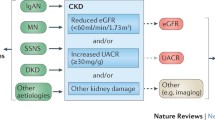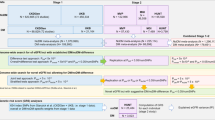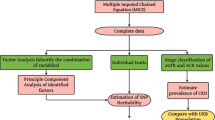Abstract
Genome-wide association studies (GWAS) have been very successful in unraveling the polygenic structure of several complex diseases and traits. In the case of albuminuria, despite the large sample size achieved by some studies, results look sparse with a limited number of loci reported so far. This review searched for GWAS studies of albumin excretion, albuminuria, and proteinuria. The resulting picture sets elements of uniqueness for albuminuria GWAS with respect to other complex traits. So far, very few loci associated with albuminuria have been validated by means of genome-wide significant evidence or formal replication. With rare exceptions, the validated loci are ethnicity specific. Within a given ethnicity, variants are common and have relatively large effects, especially in the presence of diabetes. In most cases, the identified variants were functional and a biological involvement of the target genes in renal damage was established. Recently reported variants associated with albuminuria in diabetes may be potentially combined into a genetic risk score, making it possible to rank diabetic patients by increasing risk of albuminuria. Validation of this model is required. To expand the understanding of the biological basis of albumin excretion regulation, future initiatives should achieve larger sample sizes and favor a transethnic study design.


Similar content being viewed by others
References
Levey AS, de Jong PE, Coresh J, El Nahas M, Astor BC, Matsushita K et al (2011) The definition, classification, and prognosis of chronic kidney disease: a KDIGO controversies conference report. Kidney Int 80:17–28
Chronic Kidney Disease Prognosis Consortium, Matsushita K, van der Velde M, Astor BC, Woodward M, Levey AS et al (2010) Association of estimated glomerular filtration rate and albuminuria with all-cause and cardiovascular mortality in general population cohorts: a collaborative meta-analysis. Lancet 375:2073–2081
Matsushita K, Coresh J, Sang Y, Chalmers J, Fox C, Guallar E et al (2015) Estimated glomerular filtration rate and albuminuria for prediction of cardiovascular outcomes: a collaborative meta-analysis of individual participant data. Lancet Diabetes Endocrinol 3:514–525
O’Seaghdha CM, Fox CS (2011) Genome-wide association studies of chronic kidney disease: what have we learned? Nat Rev Nephrol 8:89–99
Regele F, Jelencsics K, Shiffman D, Pare G, McQueen MJ, Mann JF et al (2015) Genome-wide studies to identify risk factors for kidney disease with a focus on patients with diabetes. Nephrol Dial Transplant 30(Suppl 4):iv26-34
Wuttke M, Kottgen A (2016) Insights into kidney diseases from genome-wide association studies. Nat Rev Nephrol 12:549–562
Maeda S, Kobayashi MA, Araki S, Babazono T, Freedman BI, Bostrom MA et al (2010) A single nucleotide polymorphism within the acetyl-coenzyme A carboxylase beta gene is associated with proteinuria in patients with type 2 diabetes. PLoS Genet 6:e1000842
Sandholm N, Salem RM, McKnight AJ, Brennan EP, Forsblom C, Isakova T et al (2012) New susceptibility loci associated with kidney disease in type 1 diabetes. PLoS Genet 8:e1002921
Sandholm N, Van Zuydam N, Ahlqvist E, Juliusdottir T, Deshmukh HA, Rayner NW et al (2017) The genetic landscape of renal complications in type 1 diabetes. J Am Soc Nephrol 28:557–574
McDonough CW, Palmer ND, Hicks PJ, Roh BH, An SS, Cooke JN et al (2011) A genome-wide association study for diabetic nephropathy genes in African Americans. Kidney Int 79:563–572
Iyengar SK, Sedor JR, Freedman BI, Kao WH, Kretzler M, Keller BJ et al (2015) Genome-wide association and trans-ethnic meta-analysis for advanced diabetic kidney disease: family investigation of nephropathy and diabetes (FIND). PLoS Genet 11:e1005352
Zeni L, Norden AGW, Cancarini G, Unwin RJ (2017) A more tubulocentric view of diabetic kidney disease. J Nephrol. doi:10.1007/s40620-017-0423-9
Boger CA, Chen MH, Tin A, Olden M, Kottgen A, de Boer IH et al (2011) CUBN is a gene locus for albuminuria. J Am Soc Nephrol 22:555–570
Brown LA, Sofer T, Stilp AM, Baier LJ, Kramer HJ, Masindova I et al (2017) Admixture mapping identifies an amerindian ancestry locus associated with albuminuria in hispanics in the United States. J Am Soc Nephrol 28:2211–2220
Rao M, Mottl AK, Cole SA, Umans JG, Freedman BI, Bowden DW et al (2012) Meta-analysis of genome-wide linkage scans for renal function traits. Nephrol Dial Transplant 27:647–656
Wijsman EM (2012) The role of large pedigrees in an era of high-throughput sequencing. Hum Genet 131:1555–1563
Hwang SJ, Yang Q, Meigs JB, Pearce EN, Fox CS (2007) A genome-wide association for kidney function and endocrine-related traits in the NHLBI’s Framingham Heart Study. BMC Med Genet 8(Suppl 1):S10
Teumer A, Tin A, Sorice R, Gorski M, Yeo NC, Chu AY et al (2016) Genome-wide association studies identify genetic loci associated with albuminuria in diabetes. Diabetes 65:803–817
Sandholm N, Forsblom C, Makinen VP, McKnight AJ, Osterholm AM, He B et al (2014) Genome-wide association study of urinary albumin excretion rate in patients with type 1 diabetes. Diabetologia 57:1143–1153
Wuttke M, Wong CS, Wuhl E, Epting D, Luo L, Hoppmann A et al (2016) Genetic loci associated with renal function measures and chronic kidney disease in children: the pediatric investigation for genetic factors linked with renal progression consortium. Nephrol Dial Transplant 31:262–269
Kramer HJ, Stilp AM, Laurie CC, Reiner AP, Lash J, Daviglus ML et al (2017) African ancestry-specific alleles and kidney disease risk in hispanics/latinos. J Am Soc Nephrol 28:915–922
Skol AD, Scott LJ, Abecasis GR, Boehnke M (2006) Joint analysis is more efficient than replication-based analysis for two-stage genome-wide association studies. Nat Genet 38:209–213
Thomas DC, Casey G, Conti DV, Haile RW, Lewinger JP, Stram DO (2009) Methodological issues in multistage genome-wide association studies. Stat Sci 24:414–429
Gogele M, Minelli C, Thakkinstian A, Yurkiewich A, Pattaro C, Pramstaller PP et al (2012) Methods for meta-analyses of genome-wide association studies: critical assessment of empirical evidence. Am J Epidemiol 175:739–749
Reznichenko A, Snieder H, van den Born J, de Borst MH, Damman J, van Dijk MC et al (2012) CUBN as a novel locus for end-stage renal disease: insights from renal transplantation. PLoS One 7:e36512
Naik RP, Derebail VK, Grams ME, Franceschini N, Auer PL, Peloso GM et al (2014) Association of sickle cell trait with chronic kidney disease and albuminuria in African Americans. JAMA 312:2115–2125
Boerries M, Grahammer F, Eiselein S, Buck M, Meyer C, Goedel M et al (2013) Molecular fingerprinting of the podocyte reveals novel gene and protein regulatory networks. Kidney Int 83:1052–1064
Shah VN, Cheema BS, Sharma R, Khullar M, Kohli HS, Ahluwalia TS et al (2013) ACACbeta gene (rs2268388) and AGTR1 gene (rs5186) polymorphism and the risk of nephropathy in Asian Indian patients with type 2 diabetes. Mol Cell Biochem 372:191–198
Tang SC, Leung VT, Chan LY, Wong SS, Chu DW, Leung JC et al (2010) The acetyl-coenzyme A carboxylase beta (ACACB) gene is associated with nephropathy in Chinese patients with type 2 diabetes. Nephrol Dial Transplant 25:3931–3934
Lin LI (1989) A concordance correlation coefficient to evaluate reproducibility. Biometrics 45:255–268
Sherry ST, Ward MH, Kholodov M, Baker J, Phan L, Smigielski EM et al (2001) dbSNP: the NCBI database of genetic variation. Nucleic Acids Res 29:308–311
Speir ML, Zweig AS, Rosenbloom KR, Raney BJ, Paten B, Nejad P et al (2016) The UCSC genome browser database: 2016 update. Nucleic Acids Res 44:D717-25
Johnson AD, Handsaker RE, Pulit SL, Nizzari MM, O’Donnell CJ, de Bakker PI (2008) SNAP: a web-based tool for identification and annotation of proxy SNPs using HapMap. Bioinformatics 24:2938–2939
Machiela MJ, Chanock SJ (2015) LDlink: a web-based application for exploring population-specific haplotype structure and linking correlated alleles of possible functional variants. Bioinformatics 31:3555–3557
Tanaka N, Babazono T, Saito S, Sekine A, Tsunoda T, Haneda M et al (2003) Association of solute carrier family 12 (sodium/chloride) member 3 with diabetic nephropathy, identified by genome-wide analyses of single nucleotide polymorphisms. Diabetes 52:2848–2853
Shimazaki A, Kawamura Y, Kanazawa A, Sekine A, Saito S, Tsunoda T et al (2005) Genetic variations in the gene encoding ELMO1 are associated with susceptibility to diabetic nephropathy. Diabetes 54:1171–1178
Zain M, Awan FR, Najam SS, Islam M, Khan AR, Bilal A et al (2017) Association of ACACB gene polymorphism (rs2268388, G > A) with type 2 diabetes and end stage renal disease in Pakistani Punjabi population. Meta Gene 12:109–112
Ovunc B, Otto EA, Vega-Warner V, Saisawat P, Ashraf S, Ramaswami G et al (2011) Exome sequencing reveals cubilin mutation as a single-gene cause of proteinuria. J Am Soc Nephrol 22:1815–1820
Christensen EI, Birn H, Storm T, Weyer K, Nielsen R (2012) Endocytic receptors in the renal proximal tubule. Physiology (Bethesda) 27:223–236
Dickson LE, Wagner MC, Sandoval RM, Molitoris BA (2014) The proximal tubule and albuminuria: really!. J Am Soc Nephrol 25:443–453
Chasman DI, Fuchsberger C, Pattaro C, Teumer A, Boger CA, Endlich K et al (2012) Integration of genome-wide association studies with biological knowledge identifies six novel genes related to kidney function. Hum Mol Genet 21:5329–5343
Pattaro C, Kottgen A, Teumer A, Garnaas M, Boger CA, Fuchsberger C et al (2012) Genome-wide association and functional follow-up reveals new loci for kidney function. PLoS Genet 8:e1002584
Rangel-Filho A, Sharma M, Datta YH, Moreno C, Roman RJ, Iwamoto Y et al (2005) RF-2 gene modulates proteinuria and albuminuria independently of changes in glomerular permeability in the fawn-hooded hypertensive rat. J Am Soc Nephrol 16:852–856
Habuchi H, Tanaka M, Habuchi O, Yoshida K, Suzuki H, Ban K et al (2000) The occurrence of three isoforms of heparan sulfate 6-O-sulfotransferase having different specificities for hexuronic acid adjacent to the targeted N-sulfoglucosamine. J Biol Chem 275:2859–2868
Kolset SO, Reinholt FP, Jenssen T (2012) Diabetic nephropathy and extracellular matrix. J Histochem Cytochem 60:976–986
Masola V, Gambaro G, Tibaldi E, Onisto M, Abaterusso C, Lupo A (2011) Regulation of heparanase by albumin and advanced glycation end products in proximal tubular cells. Biochim Biophys Acta 1813:1475–1482
Kottgen A, Pattaro C, Boger CA, Fuchsberger C, Olden M, Glazer NL et al (2010) New loci associated with kidney function and chronic kidney disease. Nat Genet 42:376–384
Pattaro C, Teumer A, Gorski M, Chu AY, Li M, Mijatovic V et al (2016) Genetic associations at 53 loci highlight cell types and biological pathways relevant for kidney function. Nat Commun 7:10023
Parsa A, Fuchsberger C, Kottgen A, O’Seaghdha CM, Pattaro C, de Andrade M et al (2013) Common variants in Mendelian kidney disease genes and their association with renal function. J Am Soc Nephrol 24:2105–2117
Welter D, MacArthur J, Morales J, Burdett T, Hall P, Junkins H et al (2014) The NHGRI GWAS Catalog, a curated resource of SNP-trait associations. Nucleic Acids Res 42:D1001-6
Staley JR, Blackshaw J, Kamat MA, Ellis S, Surendran P, Sun BB et al (2016) PhenoScanner: a database of human genotype-phenotype associations. Bioinformatics 32:3207–3209
Leslie R, O’Donnell CJ, Johnson AD (2014) GRASP: analysis of genotype-phenotype results from 1390 genome-wide association studies and corresponding open access database. Bioinformatics 30:i185-94
Yu W, Gwinn M, Clyne M, Yesupriya A, Khoury MJ (2008) A navigator for human genome epidemiology. Nat Genet 40:124–125
Ho J, Pandey P, Schatton T, Sims-Lucas S, Khalid M, Frank MH et al (2011) The pro-apoptotic protein Bim is a microRNA target in kidney progenitors. J Am Soc Nephrol 22:1053–1063
Chuang PY, Dai Y, Liu R, He H, Kretzler M, Jim B et al (2011) Alteration of forkhead box O (foxo4) acetylation mediates apoptosis of podocytes in diabetes mellitus. PLoS One 6:e23566
Gupta J, Kanetsky PA, Wuttke M, Kottgen A, Schaefer F, Wong CS (2016) Genome-wide association studies in pediatric chronic kidney disease. Pediatr Nephrol 31:1241–1252
Friedman DJ, Pollak MR (2011) Genetics of kidney failure and the evolving story of APOL1. J Clin Investig 121:3367–3374
Kao WH, Klag MJ, Meoni LA, Reich D, Berthier-Schaad Y, Li M et al (2008) MYH9 is associated with nondiabetic end-stage renal disease in African Americans. Nat Genet 40:1185–1192
Kopp JB, Smith MW, Nelson GW, Johnson RC, Freedman BI, Bowden DW et al (2008) MYH9 is a major-effect risk gene for focal segmental glomerulosclerosis. Nat Genet 40:1175–1184
Foster MC, Coresh J, Fornage M, Astor BC, Grams M, Franceschini N et al (2013) APOL1 variants associate with increased risk of CKD among African Americans. J Am Soc Nephrol 24:1484–1491
Parsa A, Kao WH, Xie D, Astor BC, Li M, Hsu CY et al (2013) APOL1 risk variants, race, and progression of chronic kidney disease. N Engl J Med 369:2183–2196
Jotwani V, Shlipak MG, Scherzer R, Parekh RS, Kao WH, Bennett M et al (2015) APOL1 Genotype and Glomerular and Tubular Kidney Injury in Women With HIV. Am J Kidney Dis 65:889–898
Beckerman P, Bi-Karchin J, Park AS, Qiu C, Dummer PD, Soomro I et al (2017) Transgenic expression of human APOL1 risk variants in podocytes induces kidney disease in mice. Nat Med 23:429–438
Shiffman D, Pare G, Oberbauer R, Louie JZ, Rowland CM, Devlin JJ et al (2014) A gene variant in CERS2 is associated with rate of increase in albuminuria in patients with diabetes from ONTARGET and TRANSCEND. PLoS One 9:e106631
Parsa A, Kanetsky PA, Xiao R, Gupta J, Mitra N, Limou S et al (2017) Genome-wide association of CKD progression: the chronic renal insufficiency cohort study. J Am Soc Nephrol 28:923–934
Jensen RA, Sim X, Li X, Cotch MF, Ikram MK, Holliday EG et al (2013) Genome-wide association study of retinopathy in individuals without diabetes. PLoS One 8:e54232
Chen G, Bentley A, Adeyemo A, Shriner D, Zhou J, Doumatey A et al (2012) Genome-wide association study identifies novel loci association with fasting insulin and insulin resistance in African Americans. Hum Mol Genet 21:4530–4536
Vart P, Scheven L, Lambers Heerspink HJ, de Jong PE, de Zeeuw D, Gansevoort RT et al (2016) Urine albumin-creatinine ratio versus albumin excretion for albuminuria staging: a prospective longitudinal cohort study. Am J Kidney Dis 67:70–78
Miller WG, Bruns DE, Hortin GL, Sandberg S, Aakre KM, McQueen MJ et al (2009) Current issues in measurement and reporting of urinary albumin excretion. Clin Chem 55:24–38
Miller WG, Bruns DE (2009) Laboratory issues in measuring and reporting urine albumin. Nephrol Dial Transplant 24:717–718
Wu HY, Peng YS, Chiang CK, Huang JW, Hung KY, Wu KD et al (2014) Diagnostic performance of random urine samples using albumin concentration vs ratio of albumin to creatinine for microalbuminuria screening in patients with diabetes mellitus: a systematic review and meta-analysis. JAMA Intern Med 174:1108–1115
Del Greco MF, Pattaro C, Minelli C, Thompson JR (2016) Bayesian analysis of censored response data in family-based genetic association studies. Biom J 58:1039–1053
Ellis JW, Chen MH, Foster MC, Liu CT, Larson MG, de Boer I et al (2012) Validated SNPs for eGFR and their associations with albuminuria. Hum Mol Genet 21:3293–3298
Deshmukh HA, Palmer CN, Morris AD, Colhoun HM (2013) Investigation of known estimated glomerular filtration rate loci in patients with type 2 diabetes. Diabet Med 30:1230–1235
Franceschini N, Haack K, Almasy L, Laston S, Lee ET, Best LG et al (2014) Generalization of associations of kidney-related genetic loci to American Indians. Clin J Am Soc Nephrol 9:150–158
Gorski M, Tin A, Garnaas M, McMahon GM, Chu AY, Tayo BO et al (2015) Genome-wide association study of kidney function decline in individuals of European descent. Kidney Int 87:1017–1029
Buzzetti R, Prudente S, Copetti M, Dauriz M, Zampetti S, Garofolo M et al (2017) Clinical worthlessness of genetic prediction of common forms of diabetes mellitus and related chronic complications: a position statement of the Italian Society of Diabetology. Nutr Metab Cardiovasc Dis 27:99–114
Martin AR, Gignoux CR, Walters RK, Wojcik GL, Neale BM, Gravel S et al (2017) Human demographic history impacts genetic risk prediction across diverse populations. Am J Hum Genet 100:635–649
Li YR, Keating BJ (2014) Trans-ethnic genome-wide association studies: advantages and challenges of mapping in diverse populations. Genome Med 6:91-014-0091-5 (eCollection 2014)
Viazzi F, Cappadona F, Pontremoli R (2016) Microalbuminuria in primary hypertension: a guide to optimal patient management? J Nephrol 29:747–753
Author information
Authors and Affiliations
Corresponding author
Ethics declarations
Conflict of interest
I have no conflict of interest.
Research involving human participants and/or animals
This article does not contain any studies with human participants or animals performed by any of the authors.
Rights and permissions
About this article
Cite this article
Pattaro, C. Genome-wide association studies of albuminuria: towards genetic stratification in diabetes?. J Nephrol 31, 475–487 (2018). https://doi.org/10.1007/s40620-017-0437-3
Received:
Accepted:
Published:
Issue Date:
DOI: https://doi.org/10.1007/s40620-017-0437-3




